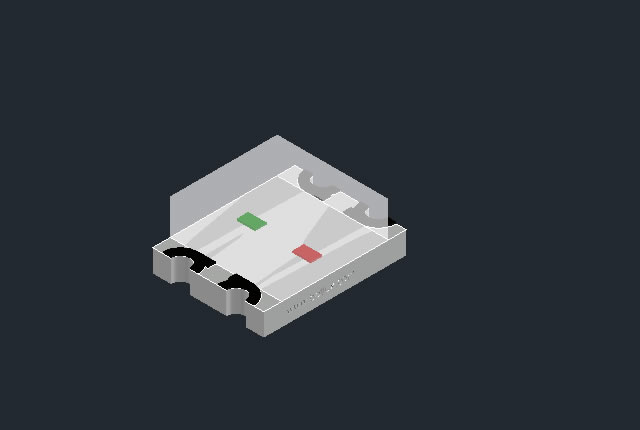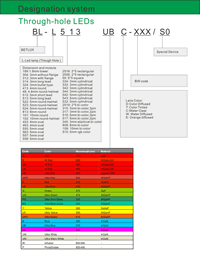smd-chip led
Series No:
Weight:(g/pcs)
Dimension:(mm)
Package:
Specification:
Inquiry
Description:
“Compact Precision and Dual Illumination: The 1612 SMD LED, Bi-Color Solution”
Introduction
In modern electronics, the demand for compact yet high-performance light sources continues to grow. The 1612 SMD LED, Bi-Color component perfectly embodies this trend, offering brightness, reliability, and versatility in an exceptionally small form factor. As a vital member of the chip LEDs family, it integrates two light-emitting chips within a single package, allowing multiple color outputs depending on circuit polarity or driving conditions.
These chip LEDs are widely used across industries—from consumer electronics to medical equipment—where dual-color indicators improve functionality and design flexibility. The bi color LED technology provides engineers and product designers with a seamless way to convey status, power, or alerts in minimal space while maintaining energy efficiency. When integrated into a well-designed diode LED circuit, the 1612 SMD LED delivers uniform light output, low heat generation, and long-term durability.
Features of the 1612 SMD LED Bi-Color
The 1612 SMD LED (1.6 mm × 1.2 mm package) has become one of the most popular chip LEDs in modern electronic design, providing an excellent balance between performance, compactness, and versatility.
Key Features:
-
Ultra-Compact Design:
With dimensions of 1.6 × 1.2 mm, it saves valuable PCB space while maintaining outstanding optical efficiency. -
Bi-Color Output:
Two separate LED chips—typically red/green or red/blue—allow for dual-state illumination within the same component. This bi color LED configuration enhances usability and design clarity. -
High Luminous Intensity:
Despite its size, the chip LEDs generate bright, uniform light, suitable for indicator or backlight applications. -
Low Power Consumption:
Optimized for minimal energy draw, making it ideal for battery-powered and portable devices. -
Wide Viewing Angle:
Delivers consistent visibility even from off-axis angles, crucial for multi-directional display readability. -
Stable Thermal Characteristics:
The diode LED structure ensures efficient heat dissipation, extending component lifespan. -
Automated Assembly Compatibility:
Fully compatible with reflow soldering and high-speed SMT production lines, simplifying manufacturing.
Applications of 1612 SMD LED Bi-Color
The versatility of the 1612 SMD LED makes it indispensable for engineers working on devices requiring compact, multi-status illumination. Its dual-color feature allows easy integration into systems that need simple visual feedback or complex RGB blending in multi-LED arrays.
-
Consumer Electronics:
Used in smartphones, wearable devices, remote controls, and home appliances for power and function indicators. -
Automotive Industry:
Incorporated into dashboard displays, switches, and control modules, where bi color LEDs improve user interaction and signal clarity. -
Medical Equipment:
Reliable chip LEDs provide color-coded feedback in compact diagnostic and monitoring tools, where clarity and precision are critical. -
Industrial Control Panels:
Used for system status indicators and operational feedback, offering durable and efficient illumination under continuous operation. -
Telecommunication Devices:
Integrated into routers and network interfaces to signal connectivity and power status. -
Wearable and Portable Gadgets:
Their low-power consumption makes them ideal for devices like fitness trackers and portable scanners. -
IoT Systems and Smart Devices:
Enables intuitive color-based notifications for real-time data or connectivity feedback.
Benefits of Using Chip LEDs Like 1612 Bi-Color
The 1612 SMD LED stands out among chip LEDs for its efficiency, design adaptability, and long-term reliability.
-
Dual-Color Communication:
The bi color LED offers two distinct color states from a single component, reducing the need for multiple LEDs and simplifying circuit layouts. -
Compact and Lightweight:
Perfect for modern electronics that demand miniaturization without compromising brightness or visibility. -
Enhanced Reliability:
Manufactured to endure mechanical stress, vibration, and temperature fluctuations common in industrial and automotive environments. -
Energy Efficient:
Consumes less power compared to through-hole or traditional diode LED options, improving energy efficiency across the system. -
Cost-Effective Solution:
Consolidating two colors in one package lowers material and assembly costs while simplifying inventory. -
High Design Flexibility:
Can be used for signal indicators, backlighting, or decorative lighting applications across various industries. -
Long Operational Life:
Designed to last over 50,000 hours with minimal color shift, ensuring product longevity.
Case Studies
Case 1 – Automotive Dashboard Indicators (Japan):
A major automotive electronics manufacturer integrated 1612 SMD LEDs into control panel buttons. The compact chip LEDs replaced bulkier alternatives, reducing board area usage by 25% while maintaining dual-color functionality for status signals.
Case 2 – Medical Diagnostics (Germany):
A leading medical device company adopted the bi color LED for portable glucose monitors. The LEDs provided intuitive red/green signaling for operation and error status, improving user experience and product reliability.
Case 3 – IoT Device Indicators (USA):
An IoT sensor manufacturer implemented 1612 SMD LEDs into its wireless modules. The diode LED technology offered precise brightness control, ensuring low-power operation without sacrificing visibility.
User Testimonials
Maria Fernandez, Electronics Engineer (Spain):
“We use chip LEDs like the 1612 series for compact designs. The dual-color output simplifies our interface designs without adding complexity.”
Alexei Petrov, Product Developer (Russia):
“The bi color LED solution improved the usability of our control systems. It’s durable, bright, and performs consistently under stress.”
David Nguyen, Purchasing Manager (Vietnam):
“Switching to 1612 SMD LEDs reduced our production cost and improved assembly efficiency. They’re now standard in our indicator modules.”
Integration in Diode LED Circuits
When incorporating the 1612 SMD LED into a diode LED circuit, engineers should optimize for current regulation, heat management, and PCB layout to ensure maximum performance.
Design Tips:
-
Use Constant-Current Drivers:
Prevent current surges that could damage the LED chips. -
Thermal Management:
Use high-conductivity substrates to efficiently dissipate heat and maintain consistent brightness. -
Polarity Control:
As a bi color LED, polarity reversal determines emitted color; careful design ensures accurate signal transitions. -
Parallel Circuit Design:
Maintain balanced voltage distribution across LEDs in multi-LED configurations. -
Protective Resistors:
Include current-limiting resistors to safeguard against excessive voltage.
Following these design principles ensures long-term stability and reliable illumination from chip LEDs like the 1612 series.
Conclusion
The 1612 SMD LED, Bi-Color diode stands as a shining example of innovation in miniaturized lighting. Combining compact dimensions, energy efficiency, and dual-color versatility, it meets the evolving needs of modern electronics.
For engineers and designers, these chip LEDs offer an exceptional balance between function and form—ideal for compact devices, IoT products, automotive systems, and industrial controls. With superior optical performance, low power consumption, and high reliability, the bi color LED continues to redefine how compact light indicators are designed and integrated.
From diode LED circuits to large-scale automation systems, the 1612 SMD LED remains an industry-trusted component that ensures precision, clarity, and long-term performance.

Features:
1.6mmx1.2mm SMD, 1612 SMD Bi-Color LED
SMD (Surface Mount Device) technology.
Compact size: 1612 package.
Bi-color capability for dual-color illumination.
Efficient and bright illumination.
WIDE VIEWING ANGLE.
Compatible with automatic placement equipment
Suitable for automatic placement on circuit boards.
Versatile design for various applications.
Commonly available in different color combinations.
PACKAGE:4KPCS/REEL
RoHS compliance.
Applications:
Indicator lights with dual-color status.
Display backlighting with two-color options.
Dual-color signage in small-scale applications.
Status indicators on circuit boards.
Decorative lighting in consumer electronics.
Wearable technology.
Portable measurement instruments.
Illumination in control panels.
Automotive interior lighting with dual colors.
General-purpose dual-color lighting applications.


Electrical-optical characteristics:
Package configuration & Internal circuit diagram
Obtain 3D specification files
To examine all 3D specifications, save the files to your local drive and open them with your 3D application.
Lens colors in 3D files are solely for visual representation; consult the Datasheet for accurate lens type and color information.
In the event of a mismatch, the dimensions in the datasheet take precedence over the 3D specifications.
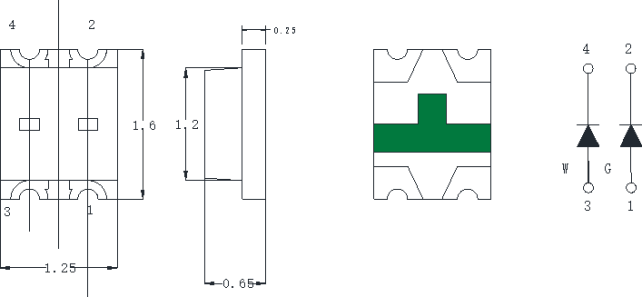
All dimensions are in millimeters(inches)
Tolerance is +-0.25(0.01″) unless otherwise note
Specifications are subject to change without notice.
Partno description:
More Information
Lens Color:
| Code | D | T | C | W | E | |
| Meaning | color Diffused | Color Tinted | Water Clear | Water Diffused | Orange diffused |
Absolute maximum ratings (Ta=25°C)
| Parameter | SR | LR | UR | UE | UY | UG | PG | BG | B | UB | UV | W | Unit |
| Forward Current I F | 25 | 25 | 25 | 30 | 30 | 30 | 30 | 30 | 30 | 30 | 30 | 30 | mA |
| Power Dissipation P d | 60 | 60 | 60 | 65 | 65 | 75 | 110 | 110 | 120 | 120 | 120 | 120 | mW |
| Reverse Voltage V R | 5 | 5 | 5 | 5 | 5 | 5 | 5 | 5 | 5 | 5 | 5 | 5 | V |
| Peak Forward Current I PF (Duty 1/10 @1KHZ) | 150 | 150 | 150 | 150 | 150 | 150 | 150 | 100 | 100 | 100 | 100 | 100 | mA |
| Operation Temperature T OPR | -40 to +80 | °C | |||||||||||
| Storage Temperature T STG | -40 to +85 | °C | |||||||||||
| Lead Soldering Temperature T SOL | Max.260+-5°C for 3 sec Max. (1.6mm from the base of the epoxy bulb) | °C | |||||||||||
Related Information
Applied for:

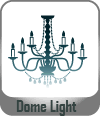
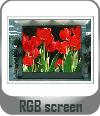
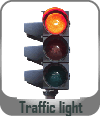
The LEDs described here are intended to be used for ordinary electronic equipment (such as office equipment,
communication equipment and household applications). Consult Betlux’s Sales in advance for information on
applications in which exceptional reliability is required, particularly when the failure or malfunction of the LEDs
may directly jeopardize life or health (such as in aviation, transportation, traffic control equipment, medical
and life support systems and safety devices).
CAUTIONS for Through-Hole LED Lamps
1. Application
The LEDs described here are intended to be used for ordinary electronic equipment (such as office equipment, communication equipment and household applications). Consult Betlux’s Sales in advance for information on applications in which exceptional reliability is required, particularly when the failure or malfunction of the LEDs may directly jeopardize life or health (such as in aviation, transportation, traffic control equipment, medical and life support systems and safety devices).
2. Storage
The storage ambient for the LEDs should not exceed 30℃ temperature or 70% relative humidity. It is
recommended that LEDs out of their original packaging are used within three months
For extended storage out of their original packaging, it is recommended that the LEDs be stored in a sealed
container with appropriate desiccant or in a desiccator with nitrogen ambient.
3. Cleaning
Use alcohol-based cleaning solvents such as isopropyl alcohol to clean the LED if necessary
4. Lead Forming & Assembly
During lead forming, the leads should be bent at a point at least 3mm from the base of LED lens. Do not use
the base of the leadframe as a fulcrum during forming.
Lead forming must be done before soldering, at normal temperature.
During assembly on PCB, use minimum clinch force possible to avoid excessive mechanical stress.

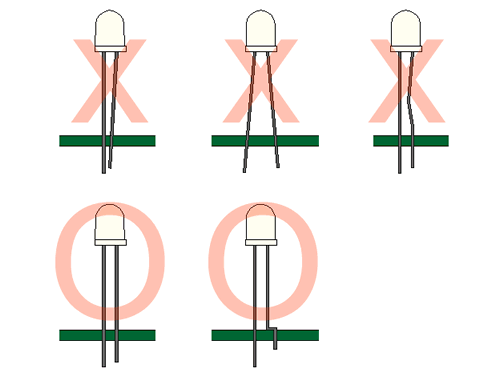
Soldering
When soldering, leave a minimum of 2mm clearance from the base of the base of the lens to the soldering point. Dipping the lens into the solder must be avoided.
Do not apply any external stress to the lead frame during soldering while the LED is at high temperature.
Recommended soldering conditions:
| IR Reflow Soldering (for SMD display) | Wave Soldering | Soldering Iron | |||
| Pre-Heat | 150-180°C | Pre-Heat | 100°C Max. | Temperature | 300°C Max. |
| Pre-Heat Time | 120sec Max. | Pre-Heat Time | 60sec Max. | ||
| Peak Temperature | 260°C Max. | SolderWave | 260°C Max. | Soldering Time | 3sec Max.(one time only) |
| Soldering Time | 10 sec Max. | Soldering Time | 5sec Max. | ||
Note: Excessive soldering temperature and/or time might result in deformation of the LED lens or failure of the LED
ESD(Electrostatic Discharge)
Static Electricity or power surge will damage the LED.
Suggestions to prevent ESD (Electrostatic Discharge):
n Use a conductive wrist band or anti-electrostatic glove when handling these LEDs
n All devices, equipment, and machinery must be properly grounded
n Work tables, storage racks, etc. should be properly grounded
n Use ion blower to neutralize the static charge which might have built up on surface of the LED’s
plastic lens as a result of friction between LEDs during storage and handling
ESD-damaged LEDs will exhibit abnormal characteristics such as high reverse leakage current,
low forward voltage, or “no light on” at low currents. To verify for ESD damage, check for “light on”
and Vf of the suspect LEDs at low currents.
The Vf of “good” LEDs should be>2.0V@0.1mA for InGaN product and >1.4V@0.1mA for AlInGaP
product.

Drive Method
An LED is a current-operated device. In order to ensure intensity uniformity on multiple LEDs connected in
parallel in an application, it is recommended that a current limiting resistor be incorporated in the drive circuit,
in series with each LED as shown in Circuit A below.
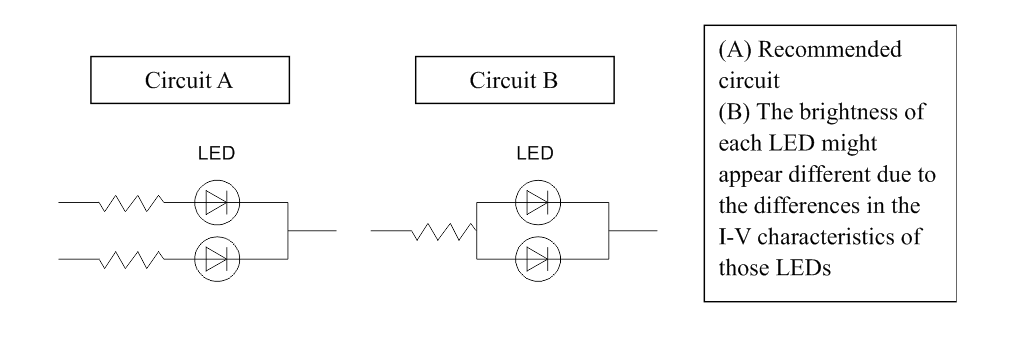
When selecting power for LED systems, it’s essential to understand several key parameters to ensure safe operation, longevity, and optimal performance. Here are some steps and considerations for LED power selection:
- Determine the Forward Voltage (Vf) of the LED(s):
Each LED has a forward voltage, which is the voltage at which the LED operates when the current is flowing through it. This value can typically be found in the LED’s datasheet.
- Determine the Forward Current (If) of the LED(s):
The forward current is the current at which the LED is designed to operate. Running an LED at higher than its rated current can reduce its lifespan and increase the heat it produces.
- Decide on the Configuration:
Series Configuration: When LEDs are connected in series, the forward voltages add up, but the current remains the same.
Parallel Configuration: When LEDs are connected in parallel, the forward voltage remains the same, but the currents add up. This configuration can be risky because if one LED fails or has a slightly lower forward voltage, it can cause the other LEDs to draw more current.
Calculate Total Power Requirements:
Power (W) = Total Forward Voltage (V) x Total Forward Current (A)
For example, if you have three LEDs connected in series, each with a forward voltage of 3V and a forward current of 20mA, the total power requirement would be:
Power = (3V + 3V + 3V) x 20mA = 9V x 0.02A = 0.18W
- Select an Appropriate Power Supply:
- Voltage Rating: The power supply voltage should match or slightly exceed the total forward voltage of your LED configuration.
- Current Rating: The power supply’s current rating should meet or exceed the total forward current of your LED configuration.
- Safety Margin: It’s a good practice to select a power supply that can provide at least 20% more power than your calculated requirement. This ensures the power supply isn’t operating at its maximum capacity, which can extend its life and ensure safer operation.
- Consider Additional Features:
- Dimming Capability: If you want to control the brightness of your LEDs, choose a power supply with dimming capabilities.
- Overcurrent and Overvoltage Protection: To protect your LEDs, select a power supply with built-in protection mechanisms.
- Thermal Management: Ensure that the power supply has adequate cooling, especially if it will be enclosed or in a location with limited airflow.
- Regulation and Efficiency:A power supply with good regulation will maintain a consistent voltage output despite variations in the load. High efficiency ensures minimal power is wasted as heat.
- Physical Size and Form Factor:Depending on where you plan to place the power supply, its size and shape may be critical factors.
In summary, when selecting power for LED systems, understanding your LED’s requirements and the configuration you plan to use is essential. Then, pick a power supply that meets those needs with some added safety margin, keeping in mind any additional features or constraints relevant to your project.
Here are some well-regarded brands in the industry:
- Mean Well: One of the most recognized brands in the LED power supply industry, Mean Well offers a wide range of products suitable for both indoor and outdoor applications. Their units often come with features like overcurrent protection, dimming capabilities, and high efficiency.
- Tridonic: A global leader in lighting technology, Tridonic offers LED drivers and power supplies that cater to various lighting solutions, from simple setups to advanced smart lighting systems.
- Philips Advance Xitanium: Philips is a well-known brand in the lighting industry, and their Xitanium series of LED drivers are known for reliability and performance. They cater to both indoor and outdoor LED applications.
- Osram: Another giant in the lighting industry, Osram offers a range of LED drivers and power supplies suitable for various applications, including architectural and street lighting.
- LIFUD: Specializing in LED drivers, LIFUD is known for its high-quality products that cater to both commercial and residential LED lighting solutions.
- MOSO: This brand offers a variety of LED drivers, especially for outdoor and industrial applications. Their products are known for durability and performance.
- TDK-Lambda: With a history in power electronics, TDK-Lambda offers a range of power supplies and LED drivers suitable for various applications, emphasizing reliability and advanced features.
Need help?
No related products found.
